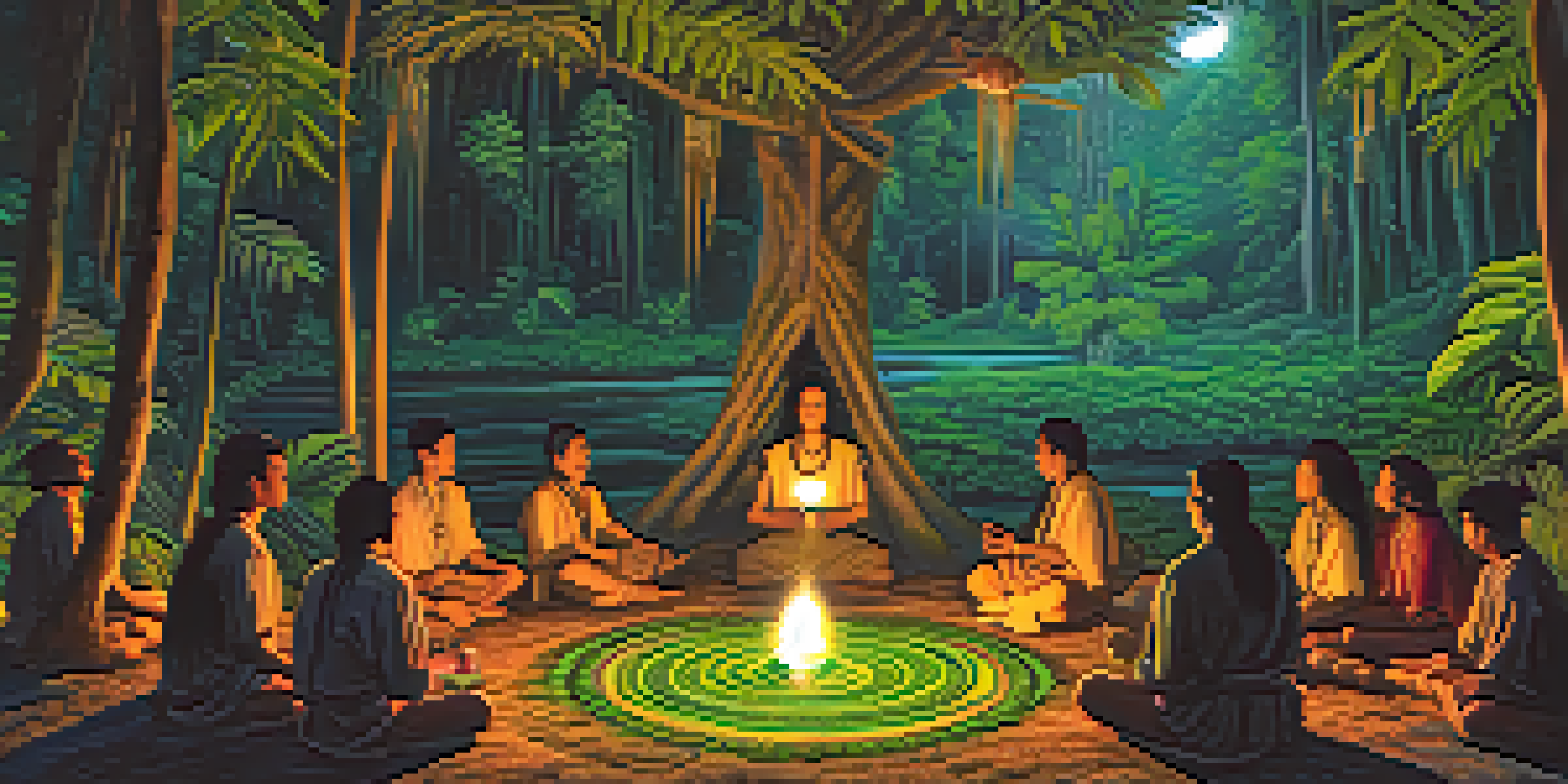Ayahuasca Ceremonies: Transformative Experiences for Participants

What is Ayahuasca and Its Cultural Significance?
Ayahuasca is a traditional plant-based brew originating from the Amazon rainforest, primarily used by indigenous tribes for spiritual and healing purposes. The brew is made from the Banisteriopsis caapi vine and the Psychotria viridis leaf, which together create a powerful psychedelic experience. This ancient ritual has been practiced for centuries, serving as a means of connecting with the spiritual world and gaining deeper insights into oneself.
The experience is not just about the visions; it’s about understanding your place in the universe.
In many South American cultures, ayahuasca is not just a drink; it's a sacred medicine that facilitates communication with the spirit realm. Participants often embark on a journey of self-discovery, guided by experienced shamans who lead the ceremonies. These shamans play a crucial role in ensuring the safety and effectiveness of the experience, often using traditional songs called icaros to guide participants through their journey.
As ayahuasca gains popularity worldwide, it’s important to respect its roots and understand the cultural significance it holds for indigenous people. The ceremonies are deeply spiritual and are often seen as a rite of passage, showcasing the importance of community, connection, and healing.
The Ceremony: What to Expect
An ayahuasca ceremony typically takes place at night, creating an atmosphere conducive to introspection and spiritual exploration. Participants usually gather in a designated space, often surrounded by nature, where they are welcomed with rituals that set the intention for the night. The shaman will explain the process, including the effects of the brew, and emphasize the importance of openness and surrender during the experience.

Once the brew is consumed, participants may experience a range of effects, including vivid visions, emotional releases, and profound insights. These experiences can vary greatly from person to person, sometimes leading to feelings of bliss or, conversely, confronting deep-seated fears and traumas. It’s not uncommon for participants to feel a sense of connection to a greater reality during this time.
Ayahuasca's Cultural Roots
Ayahuasca is a sacred brew used by indigenous tribes in the Amazon for spiritual healing and self-discovery.
Throughout the ceremony, participants are encouraged to stay present and allow the medicine to guide their journey. The shaman’s role is vital, as they provide support and safety, often intervening if someone is in distress. This supportive environment helps participants navigate their experiences and facilitates healing and transformation.
The Healing Benefits of Ayahuasca
Many participants report significant emotional and psychological healing after ayahuasca ceremonies. The brew is known to facilitate deep introspection, helping individuals confront issues like anxiety, depression, and trauma. This cathartic process can unlock suppressed emotions and lead to profound realizations about oneself and one’s life.
Ayahuasca is an opportunity to heal and transform, but it requires us to confront our deepest fears.
Research has started to back up these anecdotal claims, with studies indicating that ayahuasca may help in treating conditions such as PTSD and addiction. The experience often leads to a greater sense of purpose and connection, allowing individuals to reevaluate their lives and make positive changes. This transformative process is not just about one night; it can set the stage for lasting change.
Moreover, participants often describe a feeling of interconnectedness with others and the universe during their journey. This newfound perspective can foster compassion and empathy, which play essential roles in personal growth and healing. Ultimately, ayahuasca ceremonies can serve as catalysts for profound transformation.
Preparing for an Ayahuasca Ceremony
Preparation is key when it comes to participating in an ayahuasca ceremony. Many facilitators recommend following a dieta, which involves dietary restrictions and lifestyle changes in the days leading up to the ceremony. This might include avoiding alcohol, caffeine, and certain foods to ensure that participants are physically and mentally ready for the experience.
Mental preparation is equally important. Participants should reflect on their intentions for the ceremony, considering what they hope to learn or heal. Journaling or meditating can be useful practices to clarify these intentions. This mental readiness can significantly enhance the experience, allowing individuals to approach the ceremony with openness and curiosity.
Healing Through Ceremony
Participants often experience profound emotional healing and insights during ayahuasca ceremonies, addressing issues like anxiety and trauma.
Lastly, it’s crucial to choose a reputable retreat center or shaman to ensure a safe and respectful experience. Researching and connecting with previous participants can provide valuable insights into what to expect and help build trust in the process. A well-prepared participant is more likely to have a positive and transformative experience.
Common Experiences During the Ceremony
Participants often encounter a wide range of experiences during ayahuasca ceremonies, and these can be both exhilarating and challenging. Many report vivid visualizations, where they might see intricate patterns, landscapes, or even encounter spiritual beings. These visions can provide insights and guidance, making the experience deeply personal.
Emotional releases are another common aspect of ayahuasca journeys. Participants might find themselves crying or laughing uncontrollably as they process past traumas or unexpressed feelings. This catharsis can be incredibly healing, allowing for a release that many have been carrying for years.
However, not every experience is pleasant. Some participants may face difficult emotions or confront painful memories. This can be daunting, but it is often through these challenges that the most significant healing occurs. Understanding that discomfort can lead to growth is crucial for navigating these intense moments.
Integration: Bringing Insights into Daily Life
Integration is a vital aspect of the ayahuasca experience, as it involves processing and applying the insights gained during the ceremony into everyday life. Many participants find that the revelations they encounter can be overwhelming, and taking the time to reflect on these lessons is essential. Integration can occur through journaling, therapy, or simply discussing experiences with trusted friends or community members.
Establishing new practices or habits based on these insights can help solidify the transformation. For example, someone might feel inspired to adopt mindfulness practices, such as meditation or yoga, to maintain the sense of connection and clarity experienced during the ceremony. These changes can foster a deeper understanding of oneself and encourage continued growth.
Importance of Preparation
Proper preparation, including dietary restrictions and mental readiness, is crucial for a safe and transformative ayahuasca experience.
Support groups or integration circles are also helpful for those looking to process their experiences with others. Connecting with fellow participants can provide a sense of community and shared understanding, reinforcing the idea that healing is often a collective journey. Integration ensures that the benefits of the ceremony extend far beyond the night itself.
Is Ayahuasca Right for You?
Deciding to participate in an ayahuasca ceremony is a deeply personal choice that requires careful consideration. It’s essential to reflect on your motivations and readiness for such a profound experience. While many people find ayahuasca transformative, it may not be suitable for everyone, especially those with certain mental health conditions or sensitivities to psychedelics.
Consulting with healthcare professionals or experienced practitioners can provide valuable guidance. They can help assess whether ayahuasca aligns with your healing journey and offer insights into what to expect. It’s also crucial to engage with reputable retreat centers that prioritize safety and ethical practices.

Ultimately, the decision should come from a place of informed choice and personal readiness. For those who feel called to explore this path, ayahuasca can be a powerful tool for healing and transformation, unlocking new levels of understanding and connection.